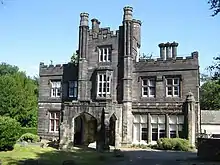Frank Harris Fulford was an entrepreneur, art collector and businessman. Born in Canada in 1868, Fulford was educated in Leipzig then he returned to Brockville, a city in Eastern Ontario, where he worked as a dealer in music.[1] He married sometime before 1902 and had three children.[1] An older brother to Charles Edward Fulford, he moved to Leeds, in England, during 1902 to manage the British division of Charles's manufacturing business, C. E. Fulford Limited.[2] The company produced patent medicines, manufacturing products including Bile Beans and Zam-Buk ointment, and was first established in the UK in 1899 after achieving success in Australia.[3] The company undertook an unsuccessful court action, and a later appeal, against an Edinburgh pharmacist in 1905 but it continued to trade and prosper despite the judge opining that the business was "founded on, and conducted by fraud".[4] A year later after the sudden death of his wealthy brother, Charles, Fulford took up the reins of the family business.[1][lower-alpha 1] He purchased Headingley Castle, Leeds, in 1909 and it became the family's main residence.[1]

A love of music remained a constant factor in Fulford's life; he had been a skilled viola player from a young age and he composed the music for the Bile Bean March, part of the marketing campaign of the company, in 1898.[1] While studying in Leipzig he began collecting modern and classical chamber music from all over the world; the collection was donated to the library at Leeds University in 1936[2] after ill health meant he was unable to play instruments.[1]
A founder member of Leeds Art Collections Fund, Fulford was also a collector of Chinese jade and other objet d'art.[2] He donated several items to be displayed in the Blue Drawing Room at the Temple Newsam museum in 1939.[2]
Fulford died at Headingley Castle, Leeds, in August 1943.[2] His wife, Lily,[8] and a daughter, Frances,[9] survived him;[2] his estate amounted to more than £198,000.[10][lower-alpha 2] A son, Jack, predeceased him in 1940.[2]
References
Notes
Citations
- 1 2 3 4 5 6 Bradford, Eveleigh, "They Lived In Leeds", northleedslifegroup.com, archived from the original on 6 February 2015, retrieved 15 February 2015
- 1 2 3 4 5 6 7 "Death of Mr F. H. Fulford", Yorkshire Evening Post, no. 16484, p. 5, 20 August 1943 – via British Newspaper Archive
- ↑ Corley, T. A. B. (1987), "Interactions between the British and American Patent Medicine Industries 1708–1914", Business and Economic History, 16: 125, ISSN 0894-6825, JSTOR 23702630
- ↑ "Bile Beans", British Medical Journal, 2 (2335): 825–826, 30 September 1905, JSTOR 20286808
- ↑ "Singular bequest to charity", Poverty Bay Herald, Papers Past, 29 December 1906, retrieved 20 February 2015
- ↑ "NOTES FROM LONDON". Kalgoorlie Western Argus. Vol. XIII, no. 628 and 629. Western Australia. 1 January 1907. p. 22. Retrieved 18 May 2017 – via National Library of Australia.
- 1 2 UK Retail Price Index inflation figures are based on data from Clark, Gregory (2017). "The Annual RPI and Average Earnings for Britain, 1209 to Present (New Series)". MeasuringWorth. Retrieved 11 June 2022.
- ↑ "Deaths", Yorkshire Post and Leeds Intelligencer, no. 29959, p. 2, 20 August 1943 – via British Newspaper Archive
- ↑ "Headingley Families United", Yorkshire Post and Leeds Intelligencer, no. 24933, p. 6, 9 June 1927 – via British Newspaper Archive
- ↑ "Latest wills", Yorkshire Post and Leeds Intelligencer, no. 30242, p. 3, 19 July 1944 – via British Newspaper Archive